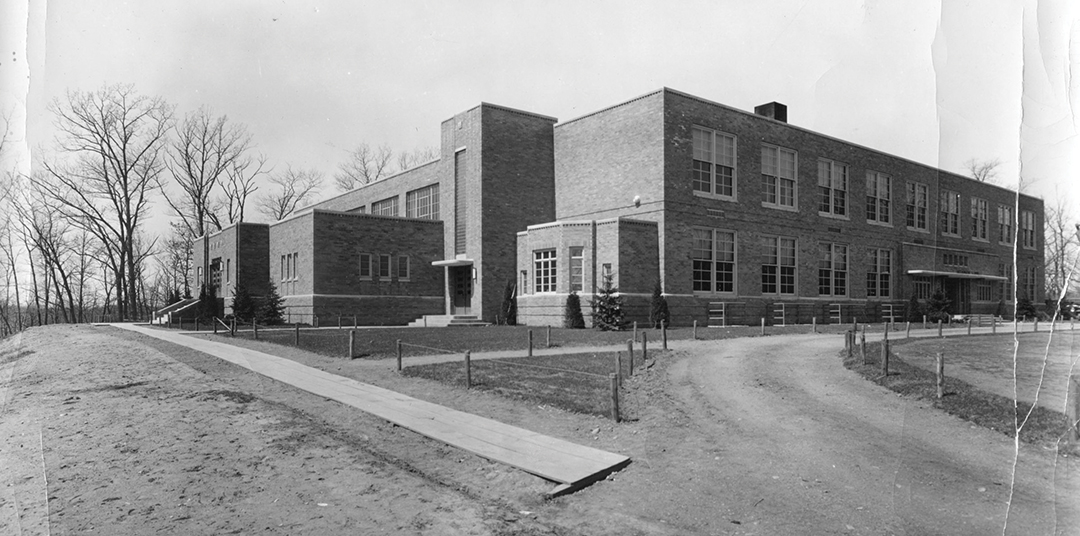
Photos: Tate Carlson
Lake Minnetonka house’s history is filled with families, guests and bon vivants.
The story of 980 Shady Lane unfolds through black-and-white photographs and the colorful memories of those who once lived in the Wayzata home. Albums hold pictures that display snippets of the house’s history: Children dressed as cowboys and Indians, performing plays during the family’s annual Wild West Days; and families and guests playing yard games, relaxing in the embrace of Lake Minnetonka’s shores.
It was a place where the full arc of family life stretched through generations—from births to closing chapters of lives lived in pastoral light of Shady Lane. And it all began with a man seeking respite from a hurried city life.
Chapter One: Henry Titus Welles and the Eastmans
“In the 1870s, there had been talk of a wonderful lake west of [Minneapolis], accessed by a muddy trail,” Winthrop Eastman, Henry Titus Welles’ great grandson, says. “To escape the hustle and bustle of the growing city, Henry Welles visited the lake and decided to acquire property for summer retreats and getaways.”
The property remained in the family for generations, and a new home replaced the original house in 1936 when a caretaker/carriage house was also built. In 1945, Winthrop Eastman’s father, Welles Eastman, and his sister, Katherine Dain, inherited the property (Dain later sold her interest to the elder Eastman). Welles Eastman and his wife, Katharine, moved into the home with their children, Welles B., Winthrop and Marilyn.
The home was called Mona Bina, Chippewa for “home for all,” and it more than lived up to its moniker. “In front of the house, so many times there were parties and just gatherings of family and guests,” Winthrop Eastman says. Part of the lawn gave way to an expansive garden, created around the time of the Great Depression. It produced a bounty of vegetables and fruits. “My mom canned everything,” Eastman says. “I remember so vividly the gauze bags she would fill with berries or grapes and then hand-squeeze them, letting the juices run into pots for making jams and jellies. Her hands were stained red and purple for days afterward.”

The home’s living room includes an open floorplan to the kitchen.
The garden had other purposes, too—yielding perfect projectiles for young boys hiding near the stone entrance gates. “The large square section of the gates is actually hollow,” Eastman says. “As kids, we would gather up tomatoes from the garden, hide inside the gate and toss the tomatoes at passing cars. Certainly naughty, but we were never caught because no one ever figured the gates were hollow.”
Eastman’s childhood meant freedom, liberation from dawn to dusk in the summertime. “The lake grants you a free backyard of literally thousands of acres of playground and adventure,” Eastman says. “As a youth without a driver’s license, all I had to do was walk down to my dock, get into my 16-foot rowboat with its seven-horsepower outboard motor, and away I would go—sometimes all day. I’d meet up with my friends around the lake who also had boats, and we would explore the far reaches and bays of Minnetonka, raid vacant beaches as pirates, etc. It was endless fun and total freedom.”
Eastman enjoyed treasured spaces within the main house, including the upstairs sleeping porch. “In the summer, as kids, we loved to sleep there, and it was always ready for sleepovers when friends would come,” he says.
Chapter Two: Willie Crear
In the mid-1970s, the sun began to set over the family’s time at 980 Shady. The children grew up and moved away. “My mother became ill with Parkinson’s and eventually had to move to the Hillcrest nursing home,” Eastman says. “Yet, every day, my father would pick her up and bring her home to 980 for the day, returning her often just after supper if not before. It was a beautiful thing to do.”

A front view of Shady Lane’s rebuilt house, completed in 1938. Historical photo courtesy of the Strommen Family.
When Eastman’s father died in 1975, he and his siblings divided the inherited property into three parcels. “My brother took the lot on the east (his widow sold it after his death), I took the middle lot (where Margie Kinney now lives), and my sister [Marilyn Eastman Kingman] took the house and property it sits on.” Though Kingman wanted to live in the home, she and her husband had settled in another residence not far away.
The family, not wanting to part with the home, hired a caretaker. “A young man, Willie Crear, had been a helper to my dad for a number of years and was quite the local bon vivant bachelor,” Eastman says. “We knew and trusted Willie, so we offered him the chance to live there.”
“That place is just magical,” Crear says. “It’s literally the best address in the state as far as I’m concerned.” Crear lived at Shady Lane alone through the winter of 1976, but then the Eastman children decided they wanted to rent out the home. To keep his address, Crear enlisted five other guys to divide the $800 a month in rent, plus utilities. “It was party central,” Crear understates.
Roommate Tim Browne created calling cards, inviting people to the house. “980 Shady,” they read, an unspoken invitation to stop by anytime. “We’d hand them out to anybody,” Crear says, easily rattling off the home’s old phone number.

Chapter Three: The Strommen Family
By the end of the summer of 1976, the home was placed on the market, starting a short series of new owners and a four-year period of vacancy, until the house was again put on the market in 2012. When that listing appeared, a Realtor friend of Jay and Heather Strommen called the couple about the enticing deal on Lake Minnetonka. Even though the Strommens weren’t currently looking to leave their Deephaven home, they decided to drive to Shady Lane.
“The second I put my hand on the doorknob and walked in, I imagined walking in hundreds of times,” Strommen says. The lake view drew her in, and visions of her daughters’ weddings danced in her head. “I think two hours later, we made an offer.”
The family, including children Emmie, 22, Jack, 20, Miles, 17 and Ruby, 15, moved into the carriage house in March 2012, where they lived for two years while the main house was reconstructed. “The carriage house is so ridiculously cute, I was worried that when we moved in [to the main house], I wouldn’t want to leave it,” Strommen says.
The main house’s floorplan didn’t suit the Strommens’ more casual lifestyle, however. “It was a formal set-up and choppy,” Strommen says, but the couple knew they wanted to maintain the vintage essence of the home, which meant keeping the shell. “We really loved how beautiful it was,” Strommen says. “We love history, and we didn’t want to mess with that.”
To help drive the vision, they enlisted the help of Jon Monson’s Landschute Group. “Jon just fell in love with the house,” Strommen says. “I could have handed the keys to Jon and said, ‘Call me when it’s done,’ ” she says. “I knew it was going to be amazing.”

Monson mirrored the Strommens’ desire to preserve the home. “Our commitment to breathing new life into vintage homes on and around the lake is unique,” he says. “It is much easier to tear down and start from scratch, so that is the common practice. In the meantime, we are losing homes with great stories of the past. I want to do what is possible to keep those stories alive.”
Since the home was vacant for about four years, there was some interior damage from neglect, the elements and animals, which had surreptitiously left their own kind of calling cards. “Suffice it to say, we took the structure down to the bare bones and rebuilt according to a design, which provided for the Strommens’ needs,” Monson explains, adding the plan included replacing “details and character that would fit with the original design.” The main house was completed in 2014.
A Mona Bina plaque now extends its welcome over the front threshold. Upon entering, even first-time visitors are blanketed in warmth and calm. With design elements planned by Strommen, with the assistance of the Sitting Room in Excelsior, the home’s décor feels natural, not staged.
The 6,693-square-foot main house features four bedrooms, four full bathrooms and two powder rooms. A modernized kitchen, which opens to the living room and a sitting area, is supplemented by a walk-in pantry and an enviable butler pantry lined with lit cabinetry. A spacious home office and a cozy den are tucked off the main living area. Strommen’s favorite space, the second-level master bedroom, features an angled entry to showcase another view of the lake.
The second level’s standout might be “the Oval Office,” a wide hallway off the master bedroom that features a circular, single-shelf bookcase rimming the ceiling with vintage titles in gentle blue, cream, green and pink hues. Charming. Clever. Captivating.
The attic has been transformed into the boys’ quarters. With space at a premium, built-in queen-size beds and dressers read practical and classic. A television/gaming area is tucked under the angled ceiling.

The master bedroom provides a lake view.
The basement’s walls and ceiling are covered in red brick, an unexpected treatment that avoids a feeling of heaviness while presenting a vintage finish. A bar area and pool table paired together give a masculine feel.
The single-car garage was transformed into a cabinet-lined storage area, adjacent to a new nine-car garage, and a porte-cochère was added to enhance the exterior. The carriage house also received a boost, going from 1,330 to 1,969 square feet, with three bedrooms, two full bathrooms and one powder room.
What is truly beautiful about the home is not just the stunning lake view that stretches across the back of the home (“It’s like watching moving art,” Strommen says), the Nantucket-influenced décor or the open floor plan that embraces intimate spaces suitable for conversations à deux or reading for one. Loveliness weaves through the home with memories—the original home’s brass-ringed skeleton keys are preserved in a frame, a 980 Shady calling card is framed for posterity (or infamy!) and an original Welles Eastman floor safe holds love letters between two high-school sweethearts—the Strommens.
Winthrop Eastman has visited the Strommens, sharing some of his 980 Shady memories, but apart from yarns about the family celebrations and childhood hijinks, he wanted the family to know something else. “He was really intent on letting us know there was a lot of love here,” Strommen says.
Perhaps just as importantly, Eastman has given the home’s renovation a nod of approval. “There are not words sufficient to describe it,” Eastman says. “Leave it as magnificent perfection. I honor the fact that the Strommens elected to restore the place rather than tear it down and build anew.”
For four generations, his family served as stewards along the storied shores of Lake Minnetonka, and Eastman is reflective. “I must say that, in the final analysis, 980 has been all about family, and not just our family,” he says. “The Andersons raised a fine family there and so did the Harrises—all benefitted from everything that location had to offer. Then, as the property was divided up, my brother raised his family of three kids there, and the Kinney family has enjoyed their place to this day. Now, it’s the Strommens’ turn. What follows is anybody’s guess.”
Visit Heather Strommen’s blog about 980 Shady Lane. More than 28,000 viewers have visited the site. “I just love design, and people seem to be really interested in this house,” she says.


























